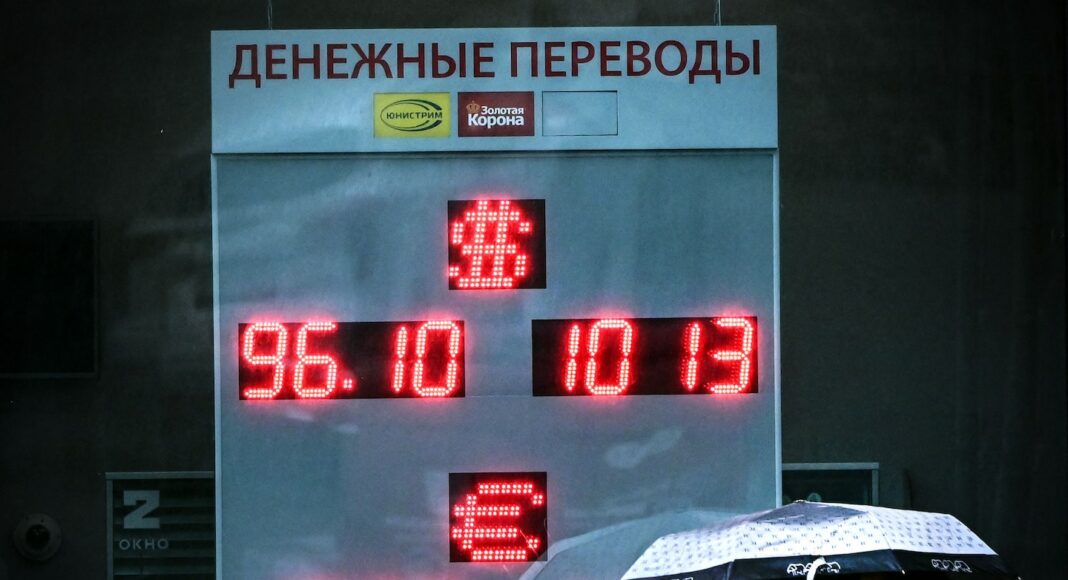Ειδήσεις Ελλάδα
Comment on this storyComment
The Russian ruble tumbled to its lowest point in 17 months Monday, briefly sliding past 102 to the dollar and prompting the country’s Central Bank to call an extraordinary meeting Tuesday to discuss the level of its key interest rate.
The ruble has lost roughly a quarter of its value against the dollar since Russia invaded Ukraine last year. Western sanctions have harmed Russia’s trade balance, and military spending has soared as the lightning offensive originally envisioned by the Kremlin has turned into a grueling battle of attrition with no end in sight.
Slow counteroffensive darkens mood in Ukraine
Russia’s Central Bank said Monday that the sudden drop in value would not threaten the country’s overall financial stability, and it blamed the fall on lagging exports alongside an increased demand for imports.
“The main source of the ruble weakening and accelerating inflation is soft monetary policy,” Maxim Oreshkin, Russian President Vladimir Putin’s economic adviser, wrote in an op-ed for the Tass news agency. “The Central Bank has all the tools to normalize the situation in the near future.”
A budget deficit and a significant labor shortage have also contributed to rising inflation. More than 40 percent of Russian industrial enterprises reported a shortage of workers last month, according to a recent survey — an acceleration of a trend that has been building since September, when Putin launched a nationwide military mobilization to shore up Russian forces in Ukraine.
Economic analysts say the recent mutiny led by Wagner boss Yevgeniy Prigozhin, as well as rumors of a new wave of mobilization, may also have driven the depreciation.
Putin appeared paralyzed and unable to act in first hours of rebellion
The ruble slid past the 100 mark Monday, down 30 percent since the start of the year, before strengthening slightly later in the day, rising to 98.5 to the dollar.
Oleg Itskhoki, a professor of economics at UCLA, said the new drop was part of a “permanent trend of depreciation” and acceleration, rather than a spontaneous crisis.
“Perhaps the current acceleration will lead to a tsunami depreciation, but this has not happened in the past,” Itskhoki said. “So it is not very likely, although not impossible, unless it triggers panic and a mass switch of savings from rubles to dollars by the broader public.”
While Russia still boasts a fairly robust trade surplus, Itskhoki said, it has not been enough to offset capital flight and stabilize the exchange rate. And standard adjustments in fiscal policy are proving inadequate.
There is “not much” the Central Bank can do, Itskhoki added, beyond reintroducing the kind of financial restrictions it deployed at the beginning of the war. Last week, the Central Bank announced that it was halting foreign currency purchases through the end of the year.
“Now is also a good time for the West to crank up financial and export sanctions to limit the fiscal space for current and future Russian war efforts in Ukraine and elsewhere,” he said.
In Ukraine, meanwhile, officials in the Black Sea port city of Odessa said Russia had launched three waves of drone and missile attacks Monday. While all 15 drones and eight missiles were shot down, the officials said, the debris caused significant damage to a supermarket, a residential building and a school. Three employees of the supermarket were injured, according to the regional governor.
Odessa has been a focus of Russian attacks since last month, when Putin terminated a United Nations-brokered deal that allowed grain exports along the Black Sea. Russian strikes this month targeted the city center and grain warehouses along the Danube River — a key alternative route for exports after the collapse of the Black Sea deal — and appeared to be aimed at crippling the country’s agricultural sector. Agriculture accounted for about 20 percent of Ukraine’s economy before the Russian invasion.
Ukrainian President Volodymyr Zelensky also visited a command post Monday for one of the brigades posted near the besieged eastern Ukrainian city of Bakhmut.
Ukrainian Deputy Defense Minister Hanna Maliar claimed advances around the flanks of Bakhmut, saying Kyiv’s forces have taken back about one square mile over the past week as part of Ukraine’s slow-moving counteroffensive. She added that Russia continues to be on the offensive to the north, near the cities of Kupyansk and Lyman, which Ukrainian troops liberated last fall.
The Biden administration announced an additional military aid package Monday to “meet Ukraine’s critical security and defense needs,” marking the 44th tranche of equipment proed to Kyiv since August 2021. The $200 million package includes additional air defense munitions for Patriot and HIMARS, artillery and tank ammunition, anti-armor weapons and mine-clearing systems.
Ebel reported from Tunis and Khurshudyan from Kyiv, Ukraine.
Understanding the Russia-Ukraine conflict



